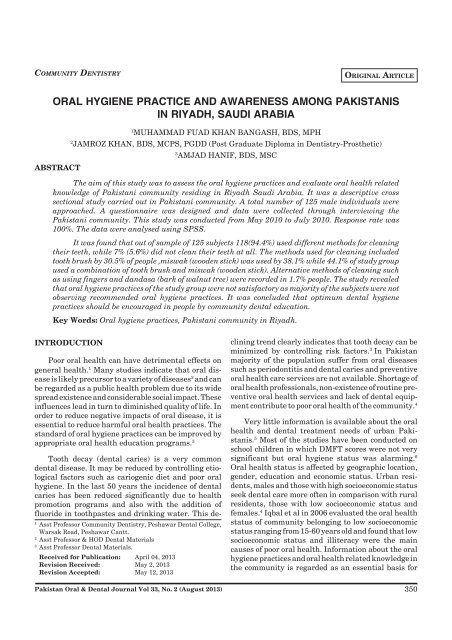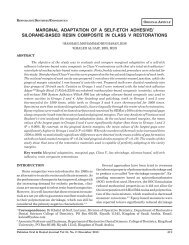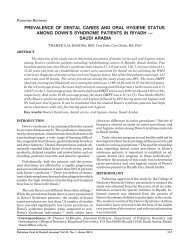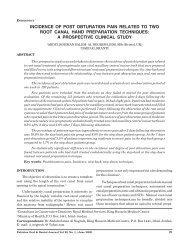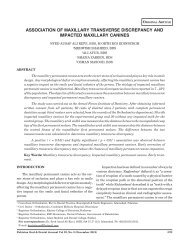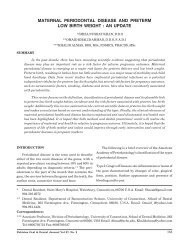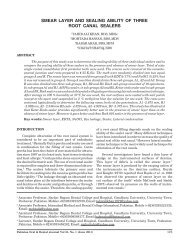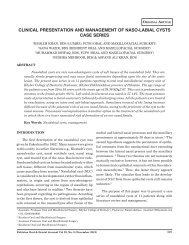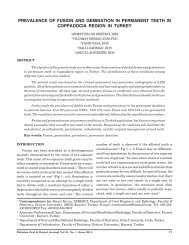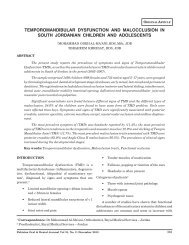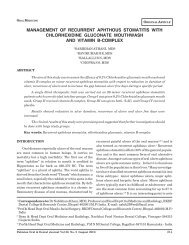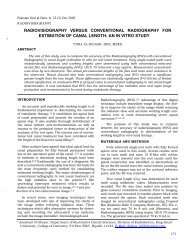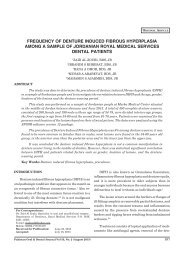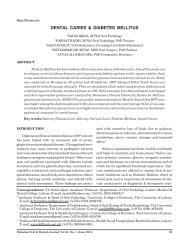oral hygiene practice and awareness among pakistanis in riyadh ...
oral hygiene practice and awareness among pakistanis in riyadh ...
oral hygiene practice and awareness among pakistanis in riyadh ...
You also want an ePaper? Increase the reach of your titles
YUMPU automatically turns print PDFs into web optimized ePapers that Google loves.
Oral Hygiene <strong>among</strong> Pakistanis <strong>in</strong> Riyadh<br />
COMMUNITY DENTISTRY<br />
ORIGINAL ARTICLE<br />
ORAL HYGIENE PRACTICE AND AWARENESS AMONG PAKISTANIS<br />
IN RIYADH, SAUDI ARABIA<br />
ABSTRACT<br />
1<br />
MUHAMMAD FUAD KHAN BANGASH, BDS, MPH<br />
2<br />
JAMROZ KHAN, BDS, MCPS, PGDD (Post Graduate Diploma <strong>in</strong> Dentistry-Prosthetic)<br />
3<br />
AMJAD HANIF, BDS, MSC<br />
The aim of this study was to assess the <strong>oral</strong> <strong>hygiene</strong> <strong>practice</strong>s <strong>and</strong> evaluate <strong>oral</strong> health related<br />
knowledge of Pakistani community resid<strong>in</strong>g <strong>in</strong> Riyadh Saudi Arabia. It was a descriptive cross<br />
sectional study carried out <strong>in</strong> Pakistani community. A total number of 125 male <strong>in</strong>dividuals were<br />
approached. A questionnaire was designed <strong>and</strong> data were collected through <strong>in</strong>terview<strong>in</strong>g the<br />
Pakistani community. This study was conducted from May 2010 to July 2010. Response rate was<br />
100%. The data were analysed us<strong>in</strong>g SPSS.<br />
It was found that out of sample of 125 subjects 118(94.4%) used different methods for clean<strong>in</strong>g<br />
their teeth, while 7% (5.6%) did not clean their teeth at all. The methods used for clean<strong>in</strong>g <strong>in</strong>cluded<br />
tooth brush by 30.5% of people ,miswak (wooden stick) was used by 38.1% while 44.1% of study group<br />
used a comb<strong>in</strong>ation of tooth brush <strong>and</strong> miswak (wooden stick). Alternative methods of clean<strong>in</strong>g such<br />
as us<strong>in</strong>g f<strong>in</strong>gers <strong>and</strong> d<strong>and</strong>asa (bark of walnut tree) were recorded <strong>in</strong> 1.7% people. The study revealed<br />
that <strong>oral</strong> <strong>hygiene</strong> <strong>practice</strong>s of the study group were not satisfactory as majority of the subjects were not<br />
observ<strong>in</strong>g recommended <strong>oral</strong> <strong>hygiene</strong> <strong>practice</strong>s. It was concluded that optimum dental <strong>hygiene</strong><br />
<strong>practice</strong>s should be encouraged <strong>in</strong> people by community dental education.<br />
Key Words: Oral <strong>hygiene</strong> <strong>practice</strong>s, Pakistani community <strong>in</strong> Riyadh.<br />
INTRODUCTION<br />
Poor <strong>oral</strong> health can have detrimental effects on<br />
general health. 1 Many studies <strong>in</strong>dicate that <strong>oral</strong> disease<br />
is likely precursor to a variety of diseases 2 <strong>and</strong> can<br />
be regarded as a public health problem due to its wide<br />
spread existence <strong>and</strong> considerable social impact. These<br />
<strong>in</strong>fluences lead <strong>in</strong> turn to dim<strong>in</strong>ished quality of life. In<br />
order to reduce negative impacts of <strong>oral</strong> disease, it is<br />
essential to reduce harmful <strong>oral</strong> health <strong>practice</strong>s. The<br />
st<strong>and</strong>ard of <strong>oral</strong> <strong>hygiene</strong> <strong>practice</strong>s can be improved by<br />
appropriate <strong>oral</strong> health education programs. 3<br />
Tooth decay (dental caries) is a very common<br />
dental disease. It may be reduced by controll<strong>in</strong>g etiological<br />
factors such as cariogenic diet <strong>and</strong> poor <strong>oral</strong><br />
<strong>hygiene</strong>. In the last 50 years the <strong>in</strong>cidence of dental<br />
caries has been reduced significantly due to health<br />
promotion programs <strong>and</strong> also with the addition of<br />
fluoride <strong>in</strong> toothpastes <strong>and</strong> dr<strong>in</strong>k<strong>in</strong>g water. This de-<br />
1<br />
Asst Professor Community Dentistry, Peshawar Dental College,<br />
Warsak Road, Peshawar Cantt.<br />
2<br />
Asst Professor & HOD Dental Materials<br />
3<br />
Asst Professor Dental Materials.<br />
Received for Publication: April 04, 2013<br />
Revision Received: May 2, 2013<br />
Revision Accepted: May 12, 2013<br />
Pakistan Oral & Dental Journal Vol 33, No. 2 (August 2013)<br />
cl<strong>in</strong><strong>in</strong>g trend clearly <strong>in</strong>dicates that tooth decay can be<br />
m<strong>in</strong>imized by controll<strong>in</strong>g risk factors. 3 In Pakistan<br />
majority of the population suffer from <strong>oral</strong> diseases<br />
such as periodontitis <strong>and</strong> dental caries <strong>and</strong> preventive<br />
<strong>oral</strong> health care services are not available. Shortage of<br />
<strong>oral</strong> health professionals, non-existence of rout<strong>in</strong>e preventive<br />
<strong>oral</strong> health services <strong>and</strong> lack of dental equipment<br />
contribute to poor <strong>oral</strong> health of the community. 4<br />
Very little <strong>in</strong>formation is available about the <strong>oral</strong><br />
health <strong>and</strong> dental treatment needs of urban Pakistanis.<br />
5 Most of the studies have been conducted on<br />
school children <strong>in</strong> which DMFT scores were not very<br />
significant but <strong>oral</strong> <strong>hygiene</strong> status was alarm<strong>in</strong>g. 6<br />
Oral health status is affected by geographic location,<br />
gender, education <strong>and</strong> economic status. Urban residents,<br />
males <strong>and</strong> those with high socioeconomic status<br />
seek dental care more often <strong>in</strong> comparison with rural<br />
residents, those with low socioeconomic status <strong>and</strong><br />
females. 4 Iqbal et al <strong>in</strong> 2006 evaluated the <strong>oral</strong> health<br />
status of community belong<strong>in</strong>g to low socioeconomic<br />
status rang<strong>in</strong>g from 15-60 years old <strong>and</strong> found that low<br />
socioeconomic status <strong>and</strong> illiteracy were the ma<strong>in</strong><br />
causes of poor <strong>oral</strong> health. Information about the <strong>oral</strong><br />
<strong>hygiene</strong> <strong>practice</strong>s <strong>and</strong> <strong>oral</strong> health related knowledge <strong>in</strong><br />
the community is regarded as an essential basis for<br />
350
Oral Hygiene <strong>among</strong> Pakistanis <strong>in</strong> Riyadh<br />
plann<strong>in</strong>g dental health <strong>awareness</strong> programs, provision<br />
of dental care facilities <strong>and</strong> personnel resources. 4<br />
The present study was under taken <strong>in</strong> order to<br />
collect prelim<strong>in</strong>ary data about <strong>oral</strong> <strong>hygiene</strong> <strong>practice</strong>s,<br />
<strong>awareness</strong> <strong>and</strong> attitude of the Pakistani community<br />
liv<strong>in</strong>g <strong>in</strong> Riyadh to <strong>oral</strong> health care. This <strong>in</strong>formation,<br />
<strong>in</strong> addition to the cl<strong>in</strong>ical data on <strong>oral</strong> <strong>hygiene</strong> <strong>practice</strong>s,<br />
will be of great help <strong>in</strong> the development <strong>and</strong><br />
monitor<strong>in</strong>g of dental health promotion strategies.<br />
METHODOLOGY<br />
Subjects <strong>in</strong>cluded <strong>in</strong> the study were 125 male<br />
Pakistani residents of Riyadh Saudi Arabia belong<strong>in</strong>g<br />
to different occupational fields. Local mosques of<br />
Riyadh were chosen to select r<strong>and</strong>om Pakistani <strong>in</strong>dividuals<br />
for fill<strong>in</strong>g out the questionnaires, hence mak<strong>in</strong>g<br />
it a community based study. The study was<br />
completed <strong>in</strong> a period of four months. Convenient<br />
sampl<strong>in</strong>g was the technique of choice for this study.<br />
Females were not <strong>in</strong>cluded <strong>in</strong> the study as it was not<br />
convenient to <strong>in</strong>terview them <strong>in</strong> the absence of a male<br />
family member due to government policies. Children<br />
also were not <strong>in</strong>cluded <strong>in</strong> the study because of limited<br />
time period s<strong>in</strong>ce it was time consum<strong>in</strong>g to identify<br />
Pakistani children <strong>in</strong> different schools of Riyadh. The<br />
study design was descriptive cross sectional. This<br />
design was chosen consider<strong>in</strong>g the time period <strong>and</strong><br />
human resources that were available <strong>and</strong> supported<br />
by the budget. S<strong>in</strong>ce the subjects under assessment<br />
were male work<strong>in</strong>g community therefore it was easier<br />
to plan <strong>and</strong> budget for a cross sectional study. A<br />
detailed questioner was designed to know about the<br />
dental <strong>hygiene</strong> <strong>practice</strong>s of the subjects. Variables<br />
<strong>in</strong>cluded the name, age, sex, address, occupation,<br />
methods of clean<strong>in</strong>g, brush<strong>in</strong>g frequency, use of<br />
miswak, clean<strong>in</strong>g material, <strong>awareness</strong> of dental diseases,<br />
frequency of visit<strong>in</strong>g the dentist, reasons for<br />
not visit<strong>in</strong>g the dentist <strong>and</strong> source of <strong>in</strong>formation of<br />
dental diseases. Data were collected by <strong>in</strong>terview<strong>in</strong>g<br />
the subjects through questionnaire <strong>and</strong> were analysed<br />
us<strong>in</strong>g SPSS version 10. Consent was taken from all<br />
the subjects that were seen <strong>and</strong> response rate of the<br />
<strong>in</strong>dividuals was 100%.<br />
RESULTS<br />
The sample population comprised of 125 <strong>in</strong>dividuals.<br />
Table 1 shows that 94.4% were clean<strong>in</strong>g their teeth<br />
while 5.6% replied <strong>in</strong> negative. About 23% of the subjects<br />
responded that they were us<strong>in</strong>g miswak while 29%<br />
replied that they were us<strong>in</strong>g tooth brush for ma<strong>in</strong>ta<strong>in</strong><strong>in</strong>g<br />
<strong>oral</strong> <strong>hygiene</strong> (Figure 1). No significant difference<br />
was observed between percentage of tooth brush users<br />
<strong>and</strong> miswak users however percentage of subjects us<strong>in</strong>g<br />
both miswak <strong>and</strong> tooth brush was higher than other<br />
Pakistan Oral & Dental Journal Vol 33, No. 2 (August 2013)<br />
groups. (Figure 2) shows that a major portion of sample<br />
was not follow<strong>in</strong>g regular twice daily regime of tooth<br />
brush<strong>in</strong>g. The number of <strong>in</strong>dividual us<strong>in</strong>g tooth brush<br />
once daily <strong>and</strong> twice daily were almost equal. Figure 2<br />
also <strong>in</strong>dicates that only a portion of the sample was<br />
observ<strong>in</strong>g <strong>oral</strong> <strong>hygiene</strong> <strong>practice</strong>s at appropriate tim<strong>in</strong>gs.<br />
Majority of the subjects replied that they were<br />
us<strong>in</strong>g miswak before prayers as device for clean<strong>in</strong>g their<br />
teeth (Table 2). It is evident from this study (Figure 3)<br />
that study group were aware of dental problems such as<br />
caries (39.7%) <strong>and</strong> periodontal disease (30.2%) but still<br />
would neglect the importance of ma<strong>in</strong>ta<strong>in</strong><strong>in</strong>g <strong>oral</strong> <strong>hygiene</strong>.<br />
It was observed that only 27% of the subjects paid<br />
a visit to their dentist out of which 24.6% went only<br />
when they experience pa<strong>in</strong>. A large proportion of the<br />
subjects (23.8%) did not visit the dentist at all (Figure<br />
4). The number of people not visit<strong>in</strong>g the dentist due to<br />
carelessness <strong>and</strong> f<strong>in</strong>ancial reasons was considerably<br />
higher as compared to other factors such as apprehension<br />
of dental treatment or pa<strong>in</strong> (Figure 5). A significant<br />
proportion of the subjects obta<strong>in</strong>ed <strong>in</strong>formation about<br />
<strong>oral</strong> <strong>hygiene</strong> from school while considerable number of<br />
<strong>in</strong>dividuals also reported that they received <strong>in</strong>formation<br />
about <strong>oral</strong> health care from electronic media <strong>and</strong><br />
dentist.<br />
DISCUSSION<br />
The present study reflects the dental <strong>hygiene</strong> <strong>practice</strong>s<br />
<strong>and</strong> <strong>awareness</strong> <strong>in</strong> Pakistani community resid<strong>in</strong>g<br />
<strong>in</strong> Riyadh. The sampl<strong>in</strong>g technique used <strong>in</strong> this study<br />
was convenient sample which had its limitations. To<br />
our knowledge no such studies have been conducted <strong>in</strong><br />
Pakistani community <strong>in</strong> Riyadh <strong>in</strong> the past.<br />
The aim of current mechanical <strong>and</strong> therapeutic<br />
approaches is to promote healthy dental <strong>and</strong> periodontal<br />
tissues by modify<strong>in</strong>g <strong>oral</strong> microflora. Regular professional<br />
care <strong>and</strong> current <strong>oral</strong> <strong>hygiene</strong> measures appropriately<br />
used are capable of virtually prevent<strong>in</strong>g<br />
caries <strong>and</strong> most periodontal disease <strong>and</strong> ma<strong>in</strong>ta<strong>in</strong><strong>in</strong>g<br />
<strong>oral</strong> health. 5 Studies have shown that the frequency of<br />
tooth brush<strong>in</strong>g had a significant association with caries<br />
prevalence. 6 Tooth brush<strong>in</strong>g habits were observed<br />
by majority of respondents (75%). This f<strong>in</strong>d<strong>in</strong>g is consistent<br />
with another study 3 conducted <strong>in</strong> Pakistan<br />
which reported 85.6% <strong>in</strong>dividuals used tooth brush to<br />
ma<strong>in</strong>ta<strong>in</strong> their <strong>oral</strong> <strong>hygiene</strong>. However major portion of<br />
the sample was not follow<strong>in</strong>g recommended regime of<br />
brush<strong>in</strong>g twice daily. In spite of brush<strong>in</strong>g be<strong>in</strong>g the<br />
most accepted method for elim<strong>in</strong>ation of plaque, 7 still<br />
its efficacy is affected by type of brush, effective technique,<br />
frequency <strong>and</strong> tim<strong>in</strong>g of brush<strong>in</strong>g. In a study<br />
conducted <strong>in</strong> Japan frequency of tooth brush<strong>in</strong>g was<br />
found to be twice daily <strong>among</strong> the participants. 8 Oral<br />
health knowledge, attitude <strong>and</strong> <strong>practice</strong>s are associated<br />
with education <strong>and</strong> socioeconomic status. 3 Im-<br />
351
Oral Hygiene <strong>among</strong> Pakistanis <strong>in</strong> Riyadh<br />
TABLE 1: FREQUENCY OF CLEANING<br />
Frequ- %age Valid Cumulative<br />
ency %age %age<br />
Valid Yes 118 93.7 94.4 94.4<br />
No 7 5.6 5.6 100<br />
Total 125 99.2 100.0<br />
Fig 4:<br />
Illustrates the percentage of how often the<br />
subject paid a visit to dentist<br />
Fig 1: Comparison of tooth clean<strong>in</strong>g devices used by<br />
the subjects<br />
Fig 5:<br />
Reasons why the subjects did not visit the<br />
dentist<br />
Fig 2:<br />
Pie diagram show<strong>in</strong>g the frequency of us<strong>in</strong>g<br />
tooth brush for clean<strong>in</strong>g teeth<br />
Fig 6:<br />
Illustrates the different sources of <strong>in</strong>formation<br />
that people obta<strong>in</strong> regard<strong>in</strong>g dental <strong>hygiene</strong>.<br />
Fig3:<br />
Diagram show<strong>in</strong>g <strong>awareness</strong> of people about<br />
dental diseases<br />
proper tooth brush<strong>in</strong>g habits might be due lower education<br />
level <strong>and</strong> low socioeconomic status as majority<br />
of <strong>in</strong>dividuals belonged to this group.<br />
From this study it was found that 78% of the<br />
subjects were us<strong>in</strong>g miswak as a device to clean their<br />
teeth either alone or <strong>in</strong> conjunction with toothbrush.<br />
This is an <strong>in</strong>dication that religion plays an important<br />
role <strong>in</strong> the life of a person if he/she is uneducated <strong>and</strong><br />
Pakistan Oral & Dental Journal Vol 33, No. 2 (August 2013)<br />
352
Oral Hygiene <strong>among</strong> Pakistanis <strong>in</strong> Riyadh<br />
unaware of the complexities of dental problems. The<br />
use of wooden stick has been encouraged by the WHO<br />
as an efficient means of dental cleanl<strong>in</strong>ess. 9,10,11 Few<br />
studies have been reported on the clean<strong>in</strong>g effectiveness<br />
of miswak. In trials with children <strong>in</strong> Ethiopia <strong>and</strong><br />
adolescents <strong>in</strong> Nigeria the wooden stick appeared to be<br />
12 13<br />
as effective as the tooth brush <strong>in</strong> remov<strong>in</strong>g plaque.<br />
A cross sectional study <strong>in</strong> Ghana <strong>among</strong> adults revealed<br />
higher plaque <strong>and</strong> g<strong>in</strong>gival bleed<strong>in</strong>g <strong>in</strong> miswak<br />
users as compared to tooth brush users. However no<br />
such difference was observed <strong>among</strong> children aged 15-<br />
17years <strong>in</strong> Tanzania. 14<br />
It was also noted that out of all the subjects under<br />
study, only 45.9% visited the dentist <strong>and</strong> that too<br />
mostly when they were fac<strong>in</strong>g any dental problem<br />
while only a small proportion of the total sample<br />
visited the dentist regularly. Bangash et al reported<br />
that those patients who were educated by their dentists<br />
about the <strong>oral</strong> <strong>hygiene</strong> were more careful <strong>and</strong><br />
were follow<strong>in</strong>g healthy <strong>oral</strong> <strong>hygiene</strong> <strong>practice</strong>s as compared<br />
to those <strong>in</strong>dividuals who were not educated by<br />
the dentist. 1<br />
In response to question regard<strong>in</strong>g barriers prevent<strong>in</strong>g<br />
them to seek dental care, 47.50% reported<br />
careless attitude as the ma<strong>in</strong> reason for not visit<strong>in</strong>g<br />
the dentist, 41% po<strong>in</strong>ted out f<strong>in</strong>ancial reasons for their<br />
unmet <strong>oral</strong> health needs while apprehension of dental<br />
treatment <strong>and</strong> pa<strong>in</strong> accounted for 4.90% <strong>and</strong> 6.60%<br />
respectively. This is <strong>in</strong> l<strong>in</strong>e with another study which<br />
reported busy rout<strong>in</strong>e <strong>and</strong> careless attitude as one of<br />
the major factor for not visit<strong>in</strong>g the dentist. 3 Other<br />
major barriers to <strong>oral</strong> health <strong>in</strong>clude socioeconomic<br />
factors, such as <strong>in</strong>ability to pay out of pocket or the<br />
problems of access that <strong>in</strong>volve transportation <strong>and</strong> the<br />
need to take time off from work. 15 Socioeconomic status<br />
has a profound effect on general health <strong>and</strong> health<br />
behaviours. Low socioeconomic status directly <strong>in</strong>fluences<br />
<strong>oral</strong> <strong>hygiene</strong> st<strong>and</strong>ards <strong>and</strong> attitudes to dental<br />
care <strong>and</strong> this study population belongs to low socioeconomic<br />
back ground. 6 Therefore apart from the perceived<br />
need, f<strong>in</strong>ancial considerations are also important,<br />
<strong>in</strong>dicative of the fact that not many people can<br />
afford the treatment unless subsidized by government<br />
or perhaps made free altogether.<br />
The lack of <strong>oral</strong> health <strong>awareness</strong> accounts for over<br />
90% of all untreated <strong>oral</strong> diseases <strong>in</strong>clud<strong>in</strong>g caries <strong>and</strong><br />
periodontal disease. Oral health knowledge deficit <strong>and</strong><br />
absence of toothache are responsible for delays <strong>in</strong><br />
seek<strong>in</strong>g dental treatment. 4 In this study it was found<br />
that the school plays a pivotal role <strong>in</strong> develop<strong>in</strong>g <strong>oral</strong><br />
health <strong>awareness</strong> while health care professionals <strong>and</strong><br />
media are also the major sources for provid<strong>in</strong>g <strong>oral</strong><br />
health related knowledge. Due to limited resources<br />
available for health sector, it is essential to adopt<br />
preventive strategies requir<strong>in</strong>g fewer resources. 6 Furthermore<br />
it is evident from this study that <strong>oral</strong> health<br />
Pakistan Oral & Dental Journal Vol 33, No. 2 (August 2013)<br />
<strong>in</strong>terventions through school can improve <strong>oral</strong> health<br />
<strong>practice</strong>s <strong>among</strong> adult population. It is acknowledged<br />
that the sample <strong>in</strong> this study was a convenience sample<br />
which may or may not represent the whole population.<br />
CONCLUSION<br />
The current study clearly <strong>in</strong>dicates that the <strong>oral</strong><br />
<strong>hygiene</strong> <strong>practice</strong>s of the study population were not<br />
satisfactory. The recommendation for the future policy<br />
is that there is a great need of health education <strong>and</strong><br />
promotion programmes to educate <strong>and</strong> motivate population<br />
towards <strong>oral</strong> health. The objectives can be<br />
achieved by utiliz<strong>in</strong>g all the resources which play role<br />
<strong>in</strong> promot<strong>in</strong>g <strong>oral</strong> health related knowledge <strong>and</strong> healthy<br />
<strong>oral</strong> <strong>hygiene</strong> habits such as educational <strong>in</strong>stitutions,<br />
health care personnel, both pr<strong>in</strong>t <strong>and</strong> electronic<br />
media.<br />
REFERENCES<br />
1 Bangash RY, Khan A, Tariq KM, Rasheed D. Evaluation of tooth<br />
brush<strong>in</strong>g technique <strong>and</strong> <strong>oral</strong> <strong>hygiene</strong> knowledge at AFID,<br />
Rawalp<strong>in</strong>di. Pak Oral Dent J. 2012; 32: 124-27.<br />
2 Malik AR, Aslam M, Malik S. Patient <strong>awareness</strong> about the risk<br />
factors <strong>and</strong> the prevention of dental diseases. Pak Oral Dent J.<br />
2012; 32: 300-303.<br />
3 Attaullah, Khan M, Khan AA. Oral health related knowledge,<br />
Attitude <strong>and</strong> <strong>practice</strong>s <strong>among</strong> patient –A study. Pak Oral Dent<br />
J. 2010; 30: 186-91.<br />
4 Bille K,Aslam M, Khan A.Government of Pakistan –M<strong>in</strong>istry of<br />
Health /WHO –Pakistan .Oral health <strong>in</strong> Pakistan A Situation<br />
analysis. Pakistan: M<strong>in</strong>istry of Health; 2003.<br />
5 Shujaat NG, Idris SH, Oral <strong>hygiene</strong> <strong>practice</strong> <strong>and</strong> <strong>awareness</strong> <strong>in</strong><br />
rural areas of Lahore. Pak Oral Dent J. 2012; 32: 283-87.<br />
6 Nazir R, Hussa<strong>in</strong> A, Kaleem M. Oral health status <strong>and</strong> malocclusion<br />
<strong>in</strong> flood affected <strong>and</strong> <strong>in</strong>ternally displaced children <strong>in</strong><br />
Pakistan. Pak Oral Dent J. 2012; 32: 110-14.<br />
7 Yousaf A, Aman N,Manzoor MA, Yasm<strong>in</strong> R, Comparison of<br />
powered <strong>and</strong> manual toothbrushes <strong>in</strong> removal of plaque. Pak<br />
Oral Dent J. 2012; 32: 120-23.<br />
8 Rizvi KF, Amanat N, Nazir R. Oral Hygiene habits <strong>among</strong><br />
patients attend<strong>in</strong>g tertiary care dental unit. Pak Oral Dent J.<br />
2012; 32: 275-78.<br />
9 Khooray T. The use of chew<strong>in</strong>g sticks <strong>in</strong> preventive <strong>oral</strong> <strong>hygiene</strong><br />
.Cl<strong>in</strong> Prev Dentistry 1983; 5: 11-4.<br />
10 Elv<strong>in</strong> –Lewis M, et al. The dental health of chew<strong>in</strong>g stick users<br />
<strong>in</strong> southern Ghana. Prelim<strong>in</strong>ary F<strong>in</strong>d<strong>in</strong>gs. J prev Dent 1982; 6:<br />
151-9.<br />
11 Asadi SGR, Asadi ZG. Chew<strong>in</strong>g sticks <strong>and</strong> the <strong>oral</strong> <strong>hygiene</strong><br />
habits of the adult Pakistani population.Int Dent J 1997; 47:<br />
275-8.<br />
12 Olsson B. Efficiency of traditional chew<strong>in</strong>g sticks <strong>in</strong> <strong>oral</strong> <strong>in</strong> <strong>oral</strong><br />
<strong>hygiene</strong> programme <strong>among</strong> Ethopian school children. Community<br />
Dent Oral Epidemol. 1978; 6: 105-9.<br />
13 Sote EO, The relative effectiveness of chew<strong>in</strong>g sticks <strong>and</strong> tooth<br />
brush on plaque removal. African Dental Journal 1987; 1: 48-53.<br />
14 Norman S, Mosha HJ, Relationship between habits <strong>and</strong> dental<br />
health <strong>among</strong> rural Tanzanian children. Community Dent Oral<br />
Epidemol. 1989; 17: 317-21.<br />
15 Gilani SI, Tanveer F, Afridi S. Oral health assessment <strong>and</strong><br />
barriers to seek care <strong>in</strong> <strong>in</strong>ternally displaced persons from bajour<br />
agency, Pakistan. Pak Oral Dent J. 2012; 32: 115-19.<br />
353


